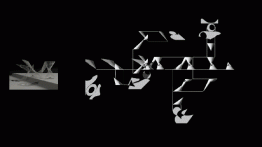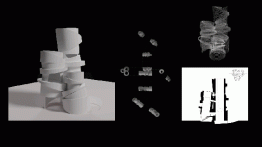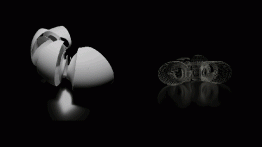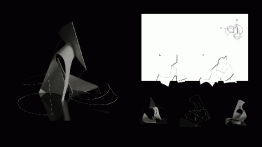The Architecture Summer Program: An Update
POSTED ON: August 29, 2024
The School of Architecture’s summer program for high school and college students, which just completed its tenth year, typically instructs about 100 students for five weeks. Introduction to Architecture Online: Foundation Studies and Portfolio Development for High School Students is for students entering or currently attending high school who are interested in exploring the fundamentals of design and thinking at the architectural scale. Introduction to Architecture Online: Foundation Studies and Portfolio Development for College Students is intended for students at the college level who are considering applying to a professional undergraduate or graduate degree program in architecture.
Because it is currently taught online, the program can accommodate students from around the world. This year, 82 students from across the US and abroad were accepted: 69 for the pre-college program and 13 at the college level. 2024 teaching assistants, who are drawn from School of Architecture students, included Fayyaadh Fadzil, Zhiye Feng, Oriol Freitas, Michaela Han, Jayne Miller, Nora McNulty, Katherine Sazhin, and Ilea Wunder. Zhiye Feng and Michael Han are alumni of the 2022 summer program and Ilea Wunder and Katherine Sazhin attended the program in 2021.
Prior summer program faculty include Michael Young, Daphne Binder, and Jeremy Jacinth. Assistant Professor Mersiha Veledar has been the program’s coordinator for the past six years. We recently caught up with her to discuss the success of this year’s endeavor and the program’s recent trajectory.
We also caught up with Mauricio Higuera, the School of Architecture’s public programs and new projects director, who administers the program’s admissions, promotion, outreach, and recruitment.
MERSIHA VELEDAR
What is your approach to teaching the summer program and what are the key objectives of the high school and college components?
Architecture begins through an embrace of primary elements where spatial preconceptions are challenged and new ways of thinking about space are discovered. Portfolio work for this summer program focuses on developing architectonic elements through an understanding of primary solids [cube, cone, cylinder, pyramid, sphere, torus] in tandem with iterative design thinking that captures lines, planes, surfaces, and volumes. Separately or in combination, this is the fundamental vocabulary of architecture.
These elemental discoveries are deployed through a rigorous understanding of space and formal iterations and an environment of architectonic playfulness. Learning how to develop experimental virtual models and space becomes a key component in re-framing concepts by introducing material and geometric properties, and phenomenological qualities such as light and atmosphere, where a student begins to develop an intuitive understanding of the relationship between space and structure. We investigate multiple meanings of structure— not only as literal structure (that which provides form and the stability to resist external forces) but also as experience—as an organizational framework for inhabitation that will be evaluated for its conceptual and aesthetic potentials, and the ways in which it produces a specific set of qualities for its inhabitants.
Each of the above spatial strategies is investigated using animate inspired drawing and model making techniques and methods; investigative translations between two-dimensional orthographic plans, sections, unrolled elevations; and three-dimensional drawing methods such as rotation drawings, iconic images, material atmospheres, animations, and details.
Precision in learning to control digital facility through virtual model making plays a key role, from one weekly phase to the next, in testing how material manipulations and geometric organization work in tandem to produce unique spaces through the precise use of elements such as columns, walls, doors, skylights, stairs, and ramps. Each of these spatial frameworks comes with a particular set of disciplines, parameters, opportunities, challenges, and histories, and we explore each one rigorously through the design of inhabitable structures: points to lines, lines to surfaces, and surfaces to volumes. The pleasure of making is fundamental to our discovery of space and the world beyond, where the imaginary becomes possible.
How long have you been teaching the summer program and how have you shaped the curriculum over the years?
I began teaching and recalibrating the curriculum structure of our two “Introduction to Architecture” summer programs at The Cooper Union in 2019, shortly after my teaching in Architectonics was recognized with a prestigious Studio Prize by Architect Magazine. Having taught a variety of courses at Cooper since 2005 that typically accommodated older students, it was important for me to create an environment of playfulness and rigor for both the pre-college and college level groups by introducing advanced digital techniques, concepts, readings, and design thinking that maximize the knowledge and ability of each student to succeed in architecture by articulating a beautiful portfolio.
The virtual platform became a great conduit through which the daily 7.5 hours of courses on advanced tools and techniques, tutorials, and portfolio reviews could be easily accessed by our domestic and global applicants without the challenges of having to live in New York for 4-5 weeks. I am grateful that the students have embraced the intensity and discipline of this new curriculum over recent years, and both programs have since doubled in size.
In parallel, I decided to connect and contextualize the work the students were making through an internal lecture series by inviting colleagues to speak about their innovative practices and research through a range of themes such as experimental constructions, affordability, cross-disciplinary collaboration in professional practice, housing, and sustainability. This year’s inspiring sequence included Nader Tehrani, Ben Aranda, Lauren Kogod, Yasmin Vobis, Stephanie Lin, James Lowder, and Anne Romme.
This program also provides an incredible opportunity for our current student body at The Cooper Union to train as teachers and pass on their knowledge while becoming devoted mentors. Moreover, this year student teaching assistants are not just some of our most accomplished and hardworking students at the school—half are also graduates of our previous pre-college summer programs and I couldn’t be prouder of them.
Why is the program so important / important to you?
I am always impressed and moved by the enthusiasm and dedication each student develops, especially in the pre-college high school group, across the span of a few intense weeks to create a stunning portfolio. Furthermore, the collective diversity of our domestic and global participants is extraordinary. We have students who form lifelong connections and friendships through the summer program, and they come not just from upstate New York, New Jersey, Connecticut, Texas, California, Vermont, Illinois, and Washington, but from around the world, including Germany, Nigeria, India, China, Great Britain, Turkey, Czech Republic, Kazakhstan, and so on. It’s been a privilege to teach such an impressive generation of students news ways of thinking and seeing the world beyond.

MAURICIO HIGUERA
How long have you been involved in the summer program, and in what capacity?
My professional involvement with the summer program began in 2016 when I joined the School of Architecture. My initial responsibility was to assist with the program's admissions process. However, after my first year as a staff member, I took on a more active approach to outreach, recruitment, and informing the program’s identity.
As far as I know, except for the Continuing Education Department, summer programs were initiated at Cooper’s three main schools in 2013 as part of a directive by former president Jamshed Barucha. Their introduction came with an administrative strategy that included tuition for the first time in the institution’s history and marked a crisis at Cooper in the way we now have to think about education and the struggle to keep it accessible. During that period, I was actively involved in the Free Cooper Union movement, a collective effort of students, faculty, staff, and alumni dedicated to safeguarding the institution's original mission. Our actions, including protests, teach-ins, occupations, and public discussions were driven by the belief that The Cooper Union is not just an educational institution but one with a profound social mission—remove either element and it ceases to be the same place.
The opportunity to attend The Cooper Union on a full scholarship opened a path for me in the U.S. in a way I had not experienced since migrating at age 13. The approach to learning, community, and creativity I encountered as a student also made a lasting impression that later, when I joined the School of Architecture staff, became ongoing aspirations, considerations, and questions.
I mention this because it would be disingenuous to ignore the disruption of tuition-based programs to what I believe is the institution’s mission, free education—as in both free of tuition and freeing or liberatory. When I transitioned to working in the School of Architecture I had to confront these questions from a different position, as a staff member, especially regarding my involvement in the summer program. That one’s work is always done collectively is a fact of life. Thus far, finding ways to imagine and communicate the value of the history of The Cooper Union within its current context has guided my contribution to the shaping of the summer programs as accessible and inclusive while providing a valuable service through education.
Can you speak about the introduction of scholarships for some of the summer program students, in terms of how they came about and the process of how the scholarship recipients are determined?
A key development during my tenure has been the introduction of scholarships, which the Acting Dean at the time, Elizabeth O’Donnell, and I initiated in 2017 with two full scholarships. These opportunities have increased every year since and jumped considerably in 2020. In response to the challenges posed by the pandemic in March of that year, Acting Dean Hayley Eber, who was then associate dean, and I made the decision to shift to online instruction, allowing us to reduce tuition significantly and grant 10% of the students full scholarships.
Part of what I have gained from working collaboratively is a growing tolerance of and appreciation for, as Donna Haraway puts it, “staying with the trouble.” Complexity, contradiction, and productive disagreement are a large part of the dynamics of having a fighting spirit in the midst of crisis—not to mention being in an office and in administrative roles while being an artist. The aspiration here is getting to a place of acceptance while continuing to try. Working with Monica Shapiro, Elizabeth O’Donnell, Nader Tehrani, and Hayley Eber has helped me get closer to integrating these threads.
You have been instrumental in the program’s growth. How has it grown in recent years? How have you expanded outreach to garner as many applications as possible each year?
Online instruction was crucial in making the program accessible to more students from all over the world, and the increase in scholarships helped us meet the needs of New York City public school students. The success of this initiative is reflected in the remarkable growth of the programs in recent years. When I first began in 2016, we had 14 college students and 25 high school students. Since then, we've expanded to a peak of 119 students in 2021 and 101 in 2023. Foremost among the factors that made this possible was the joint effort of our faculty and student teachers, their unique vision for teaching, and their aptitude for meeting the demands of a much more diverse and expanded roster.
These successes also resulted from a pragmatic approach to the way the programs are designed to meet a direct set of needs. Architecture is not commonly taught in high schools and most professional architecture programs require a portfolio and some form of related experience. Whether you come in as a high school or a college student seeking to apply to a professional undergraduate or graduate program, these needs are considered directly in every detail of our curriculum down to the title—Introduction to Architecture Online: Foundation Studies and Portfolio Development for High School and College Students. Having a clear understanding of the educational value and inclusive vision of our programs helped me hone our outreach and recruitment efforts, which include developing relationships with New York City public schools, increasing our web presence, and soliciting greater participation from our alumni and partners to promote the programs. These strategies have helped us reach a broader and more diverse pool of applicants, making the program more accessible while meeting a real educational need.





















